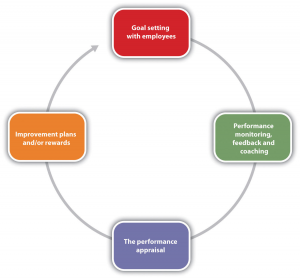Activity 1.2 | Managing and Leading in the ECE sector
Activity 1.2 | Managing and Leading in the ECE sector
Human Resource Management (HRM)
Performance Evaluations and Management

If the program you manage employs staff, you must set expectations and evaluate and manage performance.
To support and maintain your organizational culture and goals, performance management should be ongoing, and staff should be evaluated frequently to maintain standards, foster a positive learning environment, promote growth and development, identify areas for improvement, and enhance the overall quality of the working environment.
Zelda Craig and the New Caledonia (n.d.) provided comprehensive guidance on creating performance evaluations in chapter 12 of their Human Resource Management Pressbook. The authors argued that performance evaluation is a process and provided four steps to guide managers through a performance review system.
Step One
Goal setting: Showing the employee his or her performance appraisal criteria before they begin working for your program. Staff should know the expectations and how their performance will be evaluated.
Step Two
Ongoing feedback: Providing constant monitoring, feedback, and coaching. Ensuring staff know what they are doing well and not doing well informally and frequently will support quality and productivity.
Step Three
Evaluation: Conduct a formal appraisal of staff performance aligned with the explicit goals established in step one.
Step Four
Improvement Plan or Celebrate Success: In this final stage of the process, you should either (a) create a performance improvement plan to support the staff in course correction or development or (b) celebrate, acknowledge, or reward excellence.
Figure 1 Performance Review Cycle

NOTE. Figure 12.7 Performance Review System Found in Craig & College of New Caledonia (n.d.)
Reference
Craig, Z., and College of New Caledonia (n.d.). Introduction to Human Resource Management. Canadian 1st Ed. [Pressbook] CC-BY 4.0.